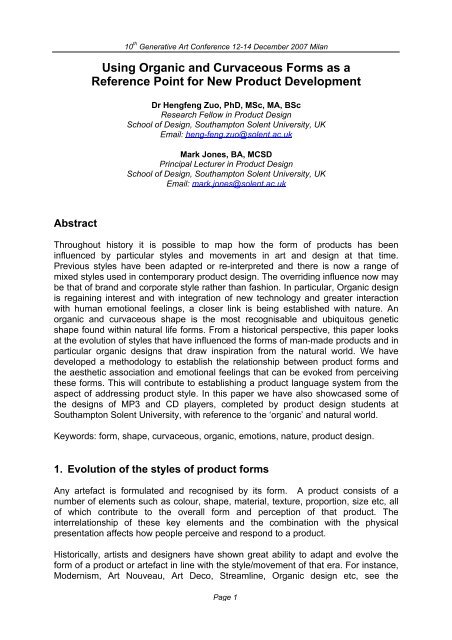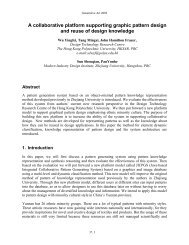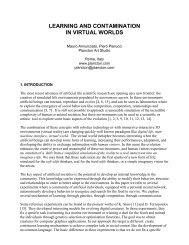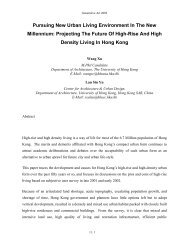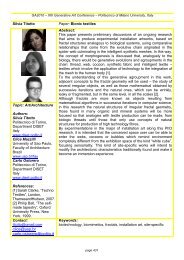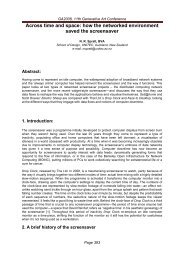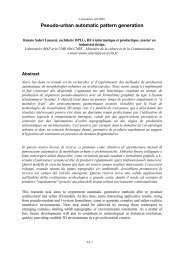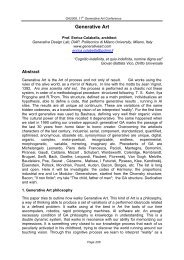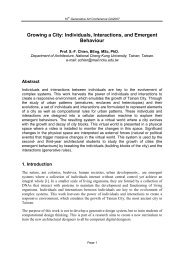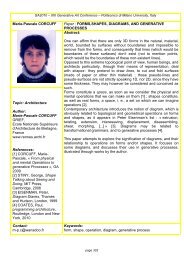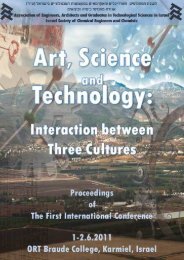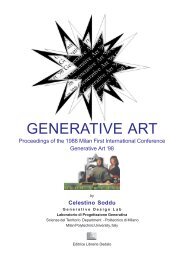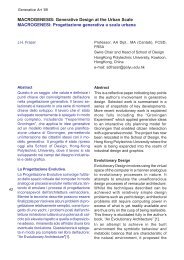Using Organic and Curvaceous Forms as a Reference Point for New ...
Using Organic and Curvaceous Forms as a Reference Point for New ...
Using Organic and Curvaceous Forms as a Reference Point for New ...
You also want an ePaper? Increase the reach of your titles
YUMPU automatically turns print PDFs into web optimized ePapers that Google loves.
Abstract<br />
10 th Generative Art Conference 12-14 December 2007 Milan<br />
<strong>Using</strong> <strong>Organic</strong> <strong>and</strong> <strong>Curvaceous</strong> <strong>Forms</strong> <strong>as</strong> a<br />
<strong>Reference</strong> <strong>Point</strong> <strong>for</strong> <strong>New</strong> Product Development<br />
Dr Hengfeng Zuo, PhD, MSc, MA, BSc<br />
Research Fellow in Product Design<br />
School of Design, Southampton Solent University, UK<br />
Email: heng-feng.zuo@solent.ac.uk<br />
Mark Jones, BA, MCSD<br />
Principal Lecturer in Product Design<br />
School of Design, Southampton Solent University, UK<br />
Email: mark.jones@solent.ac.uk<br />
Throughout history it is possible to map how the <strong>for</strong>m of products h<strong>as</strong> been<br />
influenced by particular styles <strong>and</strong> movements in art <strong>and</strong> design at that time.<br />
Previous styles have been adapted or re-interpreted <strong>and</strong> there is now a range of<br />
mixed styles used in contemporary product design. The overriding influence now may<br />
be that of br<strong>and</strong> <strong>and</strong> corporate style rather than f<strong>as</strong>hion. In particular, <strong>Organic</strong> design<br />
is regaining interest <strong>and</strong> with integration of new technology <strong>and</strong> greater interaction<br />
with human emotional feelings, a closer link is being established with nature. An<br />
organic <strong>and</strong> curvaceous shape is the most recognisable <strong>and</strong> ubiquitous genetic<br />
shape found within natural life <strong>for</strong>ms. From a historical perspective, this paper looks<br />
at the evolution of styles that have influenced the <strong>for</strong>ms of man-made products <strong>and</strong> in<br />
particular organic designs that draw inspiration from the natural world. We have<br />
developed a methodology to establish the relationship between product <strong>for</strong>ms <strong>and</strong><br />
the aesthetic <strong>as</strong>sociation <strong>and</strong> emotional feelings that can be evoked from perceiving<br />
these <strong>for</strong>ms. This will contribute to establishing a product language system from the<br />
<strong>as</strong>pect of addressing product style. In this paper we have also showc<strong>as</strong>ed some of<br />
the designs of MP3 <strong>and</strong> CD players, completed by product design students at<br />
Southampton Solent University, with reference to the ‘organic’ <strong>and</strong> natural world.<br />
Keywords: <strong>for</strong>m, shape, curvaceous, organic, emotions, nature, product design.<br />
1. Evolution of the styles of product <strong>for</strong>ms<br />
Any artefact is <strong>for</strong>mulated <strong>and</strong> recognised by its <strong>for</strong>m. A product consists of a<br />
number of elements such <strong>as</strong> colour, shape, material, texture, proportion, size etc, all<br />
of which contribute to the overall <strong>for</strong>m <strong>and</strong> perception of that product. The<br />
interrelationship of these key elements <strong>and</strong> the combination with the physical<br />
presentation affects how people perceive <strong>and</strong> respond to a product.<br />
Historically, artists <strong>and</strong> designers have shown great ability to adapt <strong>and</strong> evolve the<br />
<strong>for</strong>m of a product or artefact in line with the style/movement of that era. For instance,<br />
Modernism, Art Nouveau, Art Deco, Streamline, <strong>Organic</strong> design etc, see the<br />
Page 1
10 th Generative Art Conference 12-14 December 2007 Milan<br />
illustration in Table 1. If we look at how style is originated, one of the differences<br />
between artists <strong>and</strong> designers lies in that, artists may create works according to their<br />
personal experience <strong>and</strong> p<strong>as</strong>sion; whilst designers, particularly industrial product<br />
designers of today, need to apply more rational thinking about the <strong>for</strong>m of the product<br />
<strong>and</strong> style in relation with the product context, target market, manufacturing<br />
economics, <strong>and</strong> people’s perception.<br />
Table 1 Styles that have influenced the <strong>for</strong>m of products over time<br />
(<strong>Reference</strong> from [1], redrawn by author)<br />
In general, a product or artefact that is created will not only reflect the style <strong>and</strong><br />
influence imposed by any art <strong>and</strong> design movement of that time, together with other<br />
influences <strong>and</strong> ideological values, but will also reflect <strong>and</strong> be limited by the available<br />
technologies (<strong>for</strong> example, the material <strong>and</strong> processing technology).<br />
Let’s take radio design <strong>as</strong> an example, <strong>and</strong> give a brief overview of its <strong>for</strong>m evolution<br />
influenced by the styles over time, illustrated in Figure 1.<br />
Radio waves were discovered in 1888. Guglielmo Marconi w<strong>as</strong> the first person to<br />
have the capability to apply radio waves in communication <strong>and</strong> propag<strong>and</strong>a in 1896.<br />
Since then, the radio design h<strong>as</strong> evolved <strong>for</strong> more than a century. From the end of<br />
19 th century to the beginning of 20 th century, the Art <strong>and</strong> Crafts movement <strong>and</strong> Art<br />
Nouveau peaked in popularity. The purpose of Art <strong>and</strong> Craft movement w<strong>as</strong> to<br />
promote the ideals of traditional craft production <strong>and</strong> craftsmanship, advocated<br />
simplicity of <strong>for</strong>m. It w<strong>as</strong> featured by using simple, linear shapes with inspiration from<br />
natural plant <strong>and</strong> animal <strong>for</strong>ms (either concrete or abstract) in line with the union of<br />
<strong>for</strong>m, function <strong>and</strong> decoration. On the other h<strong>and</strong>, Art Nouveau is characterised by<br />
highly stylised, flowing, curvilinear designs often incorporating floral <strong>and</strong> other plantinspired<br />
motifs. However, it w<strong>as</strong> not until 1920s that radio had been put into<br />
commercial production. These two movements had p<strong>as</strong>sed by 1914, <strong>and</strong> had little<br />
Page 2
10 th Generative Art Conference 12-14 December 2007 Milan<br />
influence on the design of radios at that time. Nevertheless, we can still slightly<br />
glimpse the marks of Art Nouveau style by looking at the second radio sample from<br />
the top of Figure 1.<br />
Modernism, <strong>as</strong> the leading design movement in the twentieth century, emerged due<br />
to the growth in industrialisation that occurred from the 19 th to the 20 th century. With<br />
emph<strong>as</strong>is on function, modernistic design w<strong>as</strong> usually seen in the <strong>for</strong>m of simplicity<br />
such <strong>as</strong> geometrical shapes with straight lines, sharp edges <strong>and</strong> corners, cubic<br />
bodies. Although modernistic notion w<strong>as</strong> afterwards questioned by postmodernism<br />
that germinated in1960s, the style of modernism had been extending all through to<br />
late 20 th century. We can see that most of the radio samples in Figure 1 from 1930s<br />
through to 1980s took a regular geometrical shape.<br />
Figure 1 Examples showing the evolution of radio design throughout history<br />
Art Deco is an international decorative style, firstly emerged in France during the<br />
1920s. It is featured by the use of geometric <strong>and</strong> stepped <strong>for</strong>ms, however, usually<br />
with reflective surfaces, sharp edges, rounded corners <strong>and</strong> expensive materials.<br />
However, the style of Art Deco in radio design seems less obvious. As the trend <strong>for</strong><br />
Page 3
10 th Generative Art Conference 12-14 December 2007 Milan<br />
modernism evolved, the distinctive Art Deco style of the late 1920s w<strong>as</strong> overtaken by<br />
Streamline Modern design. Sharp stepped sides of skyscrapers softened into curves,<br />
while ‘boxy’ trains <strong>and</strong> automobiles were replaced with sleek, fluid lines that created<br />
the illusion of speed <strong>and</strong> motion. Streamlining w<strong>as</strong> a popular style from 1930s to<br />
1950s <strong>and</strong> even became a symbol of technological progress. We can see two or<br />
three radios from 1930s to 1950s in Figure 1 that show such streamlining<br />
characteristics, although it w<strong>as</strong> not over used. One of the advantages taken by<br />
streamlining w<strong>as</strong> the Phenolic pl<strong>as</strong>tic, which later became a symbol of progress <strong>and</strong><br />
modernity. The Streamline Modern style w<strong>as</strong> perfectly suited to c<strong>as</strong>t phenolic resins<br />
because the pl<strong>as</strong>tic e<strong>as</strong>ily flowed inside a curved mould, which facilitated shiny<br />
surfaces, curves, waterfall fronts etc. One of radios in Figure 1 h<strong>as</strong> the facades that<br />
look like car grills. Streamline style l<strong>as</strong>ted until World War II.<br />
<strong>Organic</strong> design centres round the belief that individual elements such <strong>as</strong> a piece of<br />
furniture should connect in harmony with their surroundings (interior). Usually a<br />
product with organic style takes soft, flowing lines <strong>and</strong> sculptural <strong>for</strong>ms. However, <strong>as</strong><br />
organic design w<strong>as</strong> initially rooted from the concept of organic architecture, it did not<br />
influence consumer product design to the same degree in the early stage. It is<br />
difficult to find examples of radios in Figure 1 that show this style. It is since the end<br />
of l<strong>as</strong>t century <strong>and</strong> now in 21 st century that we can see many of modern radio<br />
designs emerging with this particular style.<br />
It should be pointed out that, in parallel to changes in style, the function of the radio<br />
also evolved with the integration of additional functions since early 1980s. For<br />
example, Sony Walkman with the integration of radio <strong>and</strong> c<strong>as</strong>sette w<strong>as</strong> ever popular<br />
in 1980s <strong>and</strong> early 1990s. Today, the new digital technology <strong>and</strong> nanotechnology,<br />
smart technology h<strong>as</strong> totally brought large innovation to radio design, with regard to<br />
colourful displays, subtle tactual materials <strong>and</strong> textures, miniaturisation of size, high<br />
resolution <strong>and</strong> quality of sound, <strong>and</strong> integration of radio into other digital devices such<br />
<strong>as</strong> MP3, MP4, computer <strong>and</strong> internets etc.<br />
Today, it is noticeable that most of <strong>for</strong>mer styles are continually being revived, but<br />
with an injection of merits of contemporary features [2]. In particular, <strong>Organic</strong> design<br />
h<strong>as</strong> returned with incre<strong>as</strong>ing frequency, being used across almost all design are<strong>as</strong><br />
from architecture to furniture, interior to 3D product design. One of the most<br />
influential designers advocating organic design currently is Ross Lovegrove. Figure 2<br />
shows some of his wonderful designs with so smooth <strong>and</strong> soft contours. Current<br />
trend seems to be the mixture of different historical styles with new technology to<br />
provide a fresh approach.<br />
Figure 2 <strong>Organic</strong> designs by Ross Lovegrove<br />
2. <strong>New</strong> organic design with inspiration from nature<br />
Page 4
10 th Generative Art Conference 12-14 December 2007 Milan<br />
It is e<strong>as</strong>y to see that organic shapes are widely found within the natural world <strong>and</strong><br />
objects, such <strong>as</strong> se<strong>as</strong>hells, flower petals, water drops, flowing liquid, insects, animals,<br />
<strong>and</strong> humans per se – the human body. See figure 2.<br />
Figure 3 <strong>Organic</strong>/curvaceous <strong>for</strong>ms found in human <strong>and</strong> nature<br />
The human body is appealing with its curvaceous <strong>for</strong>ms. The only obvious parts of<br />
the body with sharp shapes <strong>and</strong> edges are the teeth <strong>and</strong> nails. Nails <strong>and</strong> teeth can be<br />
regarded <strong>as</strong> the tools <strong>for</strong> protection (grabbing) <strong>and</strong> survival (chewing food). In<br />
addition, considering our senses, physiologically, we experience a soothing sensation<br />
when our eyes see round <strong>and</strong> curvaceous shapes; we feel com<strong>for</strong>table when our<br />
h<strong>and</strong>s touch smooth surfaces; we feel ple<strong>as</strong>ure when we listen to melodic <strong>and</strong><br />
harmonious sounds; we feel happy when we smell mild <strong>and</strong> fragrant flavours; <strong>and</strong> we<br />
experience delight when our tongue t<strong>as</strong>tes delicate <strong>and</strong> delicious food etc. It would<br />
be difficult to imagine all of these positive feelings, regardless from which sensory<br />
channel, if they were connected with sharp <strong>and</strong> harsh <strong>for</strong>ms. Cognitive psychologists<br />
have explored the processing facts of human brain to multi-sensory stimuli. Results<br />
show that, ‘in the brain at le<strong>as</strong>t, your h<strong>and</strong>s are connected to your ears, which send<br />
signals to your mouth, which takes in<strong>for</strong>mation from your nose, which depends upon<br />
your eyes to tell it what it’s sensing. A product that looks appealing doesn’t just<br />
seduce the eyes. It can make the mouth water <strong>and</strong> the h<strong>and</strong>s expect’ [3].<br />
What we advocate here is that we need to give sufficient concern in design to the<br />
natural, original design <strong>and</strong> intention of life <strong>for</strong>ms, towards creating great harmony<br />
between human (including artefacts <strong>and</strong> activities) <strong>and</strong> our natural environment. We<br />
can learn from nature <strong>and</strong> obtain inspiration to look <strong>for</strong> the most natural, com<strong>for</strong>table<br />
but also the most powerful <strong>for</strong>ms <strong>and</strong> mechanisms <strong>for</strong> our man-made products, socalled<br />
biomimetic design. Biomimetics is the concept of taking ide<strong>as</strong> from nature <strong>and</strong><br />
implementing them in another technology such <strong>as</strong> engineering, design, computing,<br />
etc [4]. The concept is an old one <strong>as</strong> humans have been learning from nature since<br />
the ancient. For example, the Chinese tried to make artificial silk 3 000 years ago.<br />
However, it is only now that biomimetic design h<strong>as</strong> entered a new domain due to the<br />
following <strong>as</strong>pects:<br />
1. It h<strong>as</strong> not been until recent years that scientific research h<strong>as</strong> facilitated a closer<br />
exploration into the details of nature <strong>and</strong> its translation into industrial <strong>and</strong><br />
commercial application [5];<br />
Page 5
10 th Generative Art Conference 12-14 December 2007 Milan<br />
2. Advances in new materials <strong>and</strong> manufacturing technology now enables the<br />
various <strong>for</strong>mal aesthetic features (such <strong>as</strong> shape, colour, texture, sound etc) to<br />
more closely resemble natural <strong>for</strong>ms;<br />
3. People are getting more aware of the importance of harmony with nature, <strong>and</strong><br />
have an <strong>as</strong>piration of belonging to a green <strong>and</strong> com<strong>for</strong>table living environment;<br />
4. The plat<strong>for</strong>m <strong>for</strong> enhancing collaboration between biologists, engineers <strong>and</strong><br />
designers is being actively developed.<br />
One of the greatest designers in our history, <strong>and</strong> renown <strong>for</strong> seeking inspiration from<br />
nature, is Luigi Colani. For Colani, the natural world particular the sea life, h<strong>as</strong> been a<br />
continuing resource of inspiration. Over the years, Colani h<strong>as</strong> cited flies, whales, <strong>and</strong><br />
a wide variety of insects <strong>as</strong> the inspiration <strong>for</strong> his design works. Figure 4 shows a<br />
motorcycle model, an aircraft <strong>and</strong> tableware designed by Colani, which reflect his<br />
p<strong>as</strong>sion to the aerodynamics inspired by nature.<br />
Figure 4 Colani’s designs inspired by nature<br />
3. What we are doing <strong>and</strong> what to do next<br />
Design is no longer simply a matter of <strong>for</strong>m <strong>and</strong> function, it is not only to deliver a<br />
physical service, but also brings to people an experience, either ple<strong>as</strong>ure or<br />
disple<strong>as</strong>ure, a sort of emotion <strong>and</strong> a process of interactive participation. On the whole,<br />
it is a language to communicate with people <strong>and</strong> our surroundings. It can be<br />
hypothesised that the language of human, the language of man-made products, <strong>and</strong><br />
the language of nature can <strong>and</strong> should have something in common, which enables<br />
the smooth flowing of in<strong>for</strong>mation during the dialogue between people, artefacts <strong>and</strong><br />
environment, despite the dialogue might be mute.<br />
We have been developing a methodology addressing the product language, which<br />
our design students are currently using to manipulate <strong>and</strong> evaluate a product <strong>for</strong>m in<br />
line with particular aesthetic <strong>as</strong>sociations <strong>and</strong> application contexts. We have<br />
introduced a dual directional method.<br />
Method 1: starting from a given group of verbal descriptors that are relevant to the<br />
design topic, students collect a number of visual images that can be perceived <strong>as</strong> an<br />
interpretation of the verbal description. Initial preliminary ide<strong>as</strong> are sketched together<br />
with a selection of materials, colours <strong>and</strong> textures to align with the descriptors.<br />
Students then develop ide<strong>as</strong> into a final solution, which closely reflects the verbal<br />
description. (Perception process from verbal to images.)<br />
Page 6
10 th Generative Art Conference 12-14 December 2007 Milan<br />
Method 2: students gather a number of visual images that reflect the essence of a<br />
particular target group they are given. The images are shown to a group of people,<br />
who are <strong>as</strong>ked to give verbal description of how they feel <strong>and</strong> perceive. Following<br />
this, they move ahead with the preliminary sketch ide<strong>as</strong>, choosing materials, colours<br />
<strong>and</strong> textures to closely match the descriptors. Chosen concepts are then developed<br />
into the final design. (Perception process from images to verbal.)<br />
Both methods are about establishing the correlation between visual image <strong>and</strong><br />
vocabulary (language), used to describe these images. The methods differ in that<br />
they operate in opposite directions. In order to examine the extent to which the<br />
designs have matched both the relevant visual images <strong>and</strong> the perceived description,<br />
evaluation of the completed designs have been conducted in both c<strong>as</strong>es. B<strong>as</strong>ed on<br />
this in<strong>for</strong>mation, we then categorise this vocabulary according to the topology of<br />
products, of contexts, <strong>and</strong> of topics in aesthetic <strong>as</strong>sociation etc, which will contribute<br />
to establishing of a product language system, that will in<strong>for</strong>m practice through<br />
identifying elements <strong>and</strong> features that will be necessary ingredients in <strong>for</strong>mulating the<br />
product style.<br />
As examples, we showc<strong>as</strong>e here some of the student designs following both types of<br />
the methodology.<br />
Method 1: verbal description → visual images → design<br />
In this unit, students were <strong>as</strong>ked to design a MP3 with speakers in line with particular<br />
topics of aesthetic <strong>as</strong>sociations, each topic being represented by a group of verbal<br />
descriptors. One of these groups is: curvaceous, organic, fun. The procedure is<br />
illustrated in Figure 5. After the designs were completed, we presented the models to<br />
a different group of students <strong>for</strong> evaluation with regard to whether the style <strong>and</strong><br />
aesthetic perception of curvaceous-organic-fun h<strong>as</strong> been successfully matched.<br />
Results show that an average percentage of 70% success w<strong>as</strong> achieved in the <strong>for</strong>m<br />
<strong>and</strong> aesthetics matched the topic. There<strong>for</strong>e, method 1 is fairly effective in training<br />
students to manipulating a product <strong>for</strong>m. Similar results have also been achieved <strong>for</strong><br />
other style <strong>and</strong> aesthetic topics.<br />
Figure 5 Illustration of the procedure of MP3 design following Method 1<br />
Page 7
10 th Generative Art Conference 12-14 December 2007 Milan<br />
Method 2: visual images → verbal description → design<br />
In this unit, students were <strong>as</strong>ked to design a CD player with speakers under two<br />
contexts: <strong>for</strong> ‘an Alien species’ <strong>and</strong> <strong>for</strong> ‘Marine biologists’. They started by collecting a<br />
number of visual images that they perceived were relevant to the topics of Alien or<br />
Marine. These were presented in the <strong>for</strong>m of a style board. Each student then<br />
conducted a survey by showing the style board to a minimum of 20 people <strong>for</strong><br />
perception. People were <strong>as</strong>ked to describe how they felt <strong>and</strong> verbal descriptors were<br />
recorded. The words that appeared with highest frequency were selected to help<br />
in<strong>for</strong>m the development of design ide<strong>as</strong> through to the final <strong>for</strong>m. The procedure is<br />
shown in Figure 6, which is <strong>for</strong> designing the CD player <strong>for</strong> a Marine Biologist. Figure<br />
7 shows an example of a CD player designed <strong>for</strong> the Alien species. Evaluation of the<br />
designs with regard to whether the designs have matched the style <strong>and</strong> aesthetic<br />
topics (e.g., in the c<strong>as</strong>e shown in Figure 6, curvaceous-sleek-aquatic) is still<br />
undergoing by the time of writing this paper. Further results <strong>and</strong> comparison with<br />
those obtained in Method 1 will be reported at a later date.<br />
Figure 6 Illustration of the procedure of designing a CD player<br />
<strong>for</strong> Marine Biologists following Method 2<br />
In addition to developing a practical datab<strong>as</strong>e of product language, i.e. the<br />
vocabulary according to the categorisation of product types, user in<strong>for</strong>mation <strong>and</strong><br />
contexts, etc, our next step requires a more detailed look at the features of natural<br />
life <strong>for</strong>ms, shape, colour, textures etc. Following this, we intend to connect this<br />
in<strong>for</strong>mation with three <strong>as</strong>pects in design: senses, <strong>for</strong>ms, <strong>and</strong> emotions. We are going<br />
to explore the other sensory interaction such <strong>as</strong> touch. This will enable the<br />
methodology to go beyond deriving purely visual inspiration from nature. We also<br />
intend to look <strong>for</strong> material/finish techniques in relation to a natural surface textures.<br />
Page 8
10 th Generative Art Conference 12-14 December 2007 Milan<br />
Figure 7 Example of the CD player designed <strong>for</strong> Alien species also following Method 2<br />
4. Conclusions<br />
1. The <strong>for</strong>m of man-made objects historically w<strong>as</strong> subject to influences <strong>and</strong><br />
overriding styles within that particular era. Most previous styles have since reemerged<br />
<strong>and</strong> been fused into today’s design practice, which features a diverse<br />
multitude of styles.<br />
2. <strong>Organic</strong> design h<strong>as</strong> particularly revived, along with the new domain of Biomimetic<br />
design due to new technology <strong>and</strong> human expectation of building harmony with<br />
<strong>and</strong> returning to nature.<br />
3. A methodology is being developed to build a product <strong>for</strong>mal language system <strong>and</strong><br />
to educate young designers to manipulate <strong>for</strong>m style to facilitate an effective<br />
communication between people <strong>and</strong> product, perhaps also between product <strong>and</strong><br />
nature.<br />
<strong>Reference</strong>s<br />
1. Lakshmi Bh<strong>as</strong>karan, (2005), Designs of the times: using key movements <strong>and</strong><br />
styles <strong>for</strong> contemporary design, published by Roto Vision SA. ISBN: 2-88046-816-<br />
7.<br />
2. David Pearson, (2001), <strong>New</strong> <strong>Organic</strong> Architecture: The Breaking Wave. University<br />
of Cali<strong>for</strong>nia Press, ISBN-10: 0520232895.<br />
3. Tess Raine, (2007), Multisensory appeal, Packaging <strong>New</strong>s, 02 May 2007.<br />
4. http://www.bath.ac.uk/mech-eng/biomimetics/about.htm<br />
5. Julian F V Vincent et al, (2006), Biomimetics: its practice <strong>and</strong> theory, J R Soc<br />
Interface, 3, p471-482.<br />
Page 9


